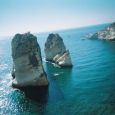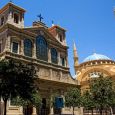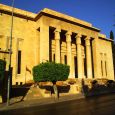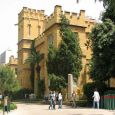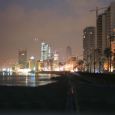Beirut
Advertisement
By Air
The city's renovated airport is the Rafic Hariri International Airport and is located in the southern suburbs.Turkish Airlines operates daily 3 flights between Istanbul and Beirut and Vice Versa.By land, the latter are served by either service taxi or taxicab.Service taxis are cheaper than normal taxis,but to avoid misunderstandings,an agreement over pricing needs to be made before setting off.
By bus
Buses from Damascus and regions south of Beirut drop passengers off at an intersection adjacent to the Cola bridge\overpass, which is located in the southern part of the city (Mazraa) a couple of km south of Hamra and southwest of downtown. From here, you can get a private taxi to Hamra or Center Ville for LL10000 or a shared "service" taxi for LL2000.Be clear with the taxi driver if you want service.If the taxi driver asks you to pay 2 or 3 service,they are asking for you to pay for two or three spots in the cab, which is usually unnecessary. Just wait for the next cab.There are about a dozen government bus routes, but service taxis are typically easier and just as cheap.
By Car
You can travel between Lebanon and Syria by private/rental car, bus, private taxi, or service taxi.Visa are not issued at the border but can be obtained from the Syrian Embassy, located in Hamra.There are four border crossing points between Lebanon and Syria are Masnaa,Qaa,Arida and Aboudiyeh.
National Museum of Beirut
Is the principal museum of archaeology in Lebanon.The collection was begun after World War I, and the museum was officially opened in 1942.The museum has collections totalling about 100,000 objects,most of which are antiquities and medieval finds from excavations undertaken by the Directorate General of Antiquities.About 1300 artifacts are exhibited,ranging in date from prehistoric times to the medieval Mamluk period.Today,after a major renovation,the National Museum of Beirut has regained its former position,especially as a leading collector for ancient Phoenician objects.
Jeita Grotto
Is a compound of crystallized caves in Lebanon located 20 km north of Beirut in the Valley of Nahr al-Kalb (Dog River).This grotto is made up of two limestone caves, upper galleries and a lower cave through which a 6230 m long river runs.Geologically, the caves provide a tunnel or escape route for the underground river.In this cave and galleries,the action of water in the limestone has created cathedral-like vaults full of various sizes,colors and shapes of stalactites and stalagmites,majestic curtains and fantastic rock formations.The total length of the cave is more than 9000 m and there is one among the biggest stalactites in the world hanging 8,20 m.The grotto accommodates a huge hall with a distance of 108 m from the ceiling till the water level.
Sursock Museum
Which is officially known as Nicolas Sursock Museum, is a modern art museum in Beirut, Lebanon. It is located in the historic street known as Rue Sursock (or Sursock Street) in the Achrafieh district of Beirut.The street is home to other mansions that were built in the 18th century by Beirut's most prominent families such as the Sursocks and the Bustroses.The Museum opened its doors in 1961 with an exhibit of works of contemporary Lebanese artists,setting a precedent for cultural events in Beirut.Since then, more than a hundred exhibitions have been held, displaying the works of both Lebanese and international artists.In addition to modern art, the museum's permanent collection includes Japanese engravings and Islamic art.
Grand Serail
Also known as the Government Palace) is the headquarters of the Prime Minister of Lebanon.It is situated atop a hill in downtown Beirut a few blocks away from the Lebanese Parliament.The Grand Serail is a historic building, the most important of three Ottoman monuments on the Serail hill.The other two are the Council for Development and Reconstruction and the Hamidiyyeh clock tower.This historic building has earned its importance through successive roles which it held since 1832.
Hamidiyyeh Clock Tower
Was designed by Youssef Aftimus,and restored in 1994 to its original condition.The Clock Tower stands 25 metres (82 ft) tall, it was the tallest structure in Beirut at the time of its completion.It was built of Beiruti sandstone,Jounieh limestone,Damascene Basalt and Deir el Qamar red stone.The clock tower's 300 kg bell, suspended on the third floor was accessible by a set of 125 cast iron steps inside the tower's 4 by 4 metres (13 ft) shaft.This floor has four miniature neo-orientalist style balconies topped by the four large French made clock faces which were especially imported by the Ottoman embassy.
Information not available


